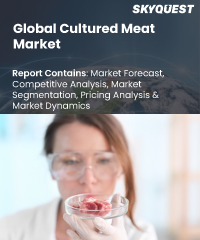
Report ID: SQMIG30I2374

Report ID:
SQMIG30I2374 |
Region:
Global |
Published Date: December, 2024
Pages:
198
|
Tables:
122 |
Figures:
77
Cultured Meat Market size was valued at USD 0 Million in 2023 and is poised to grow from USD 0 Million in 2024 to USD 0 Million by 2032, growing at a CAGR of 19.06% during the forecast period (2025-2032).
The global cultured meat market has witnessed significant growth in recent years, driven by increasing consumer demand for sustainable and ethical food alternatives. Cultured meat, also known as lab-grown or cell-based meat, is produced by culturing animal cells in a lab, eliminating the need for traditional animal farming.
Growing technology developments in the alternative protein area are propelling a global transition towards sustainable food systems. Meat replacements and alternative proteins are attracting global interest due to the rising need to address meat shortages while also addressing population growth and environmental concerns. Environmental sustainability and a growing emphasis on safeguarding meat supply are two of the causes driving the global expansion of the cultured meat business. The expanding vegan population and consumer attitudes towards animal welfare are expected to drive the expansion of cultured meat. Although the business is still in its infancy, research and development for large-scale manufacturing of cultured meat are underway. Major market participants are concentrating their efforts on gaining regulatory permits for the commercialization of cultured meat products.
Our industry expert will work with you to provide you with customized data in a short amount of time.
REQUEST FREE CUSTOMIZATIONWant to customize this report? This report can be personalized according to your needs. Our analysts and industry experts will work directly with you to understand your requirements and provide you with customized data in a short amount of time. We offer $1000 worth of FREE customization at the time of purchase.

Report ID: SQMIG30I2374